A Reconfigurable Terahertz Metamaterial Absorber for Gas Sensing Applications
Abstract
:1. Introduction
2. Structure Design Methodology
2.1. Absorption Characteristics
2.2. Design Parameter Selection
2.3. Fabrication Process
3. Absorption Mechanism, Theory and Equivalent Circuit
3.1. μ Negative Metamaterial
3.2. Equivalent Circuit
3.3. Current Distribution
4. Refractive Index Sensing
4.1. Sensitivity of the Design
4.2. Gas Detection Using the Proposed Absorber
5. Conclusions
Author Contributions
Funding
Data Availability Statement
Conflicts of Interest
References
- Li, W.; Cheng, Y. Dual-band tunable terahertz perfect metamaterial absorber based on strontium titanate (STO) resonator structure. Opt. Commun. 2020, 462, 125265. [Google Scholar] [CrossRef]
- Huang, X.; Lu, C.; Rong, C.; Hu, Z.; Liu, M. Multiband ultrathin polarization-insensitive terahertz perfect absorbers with complementary metamaterial and resonator based on high-order electric and magnetic resonances. IEEE Photonics J. 2018, 10, 1–11. [Google Scholar] [CrossRef]
- Sun, K.; Fan, R.; Zhang, X.; Zhang, Z.; Shi, Z.; Wang, N.; Xie, P.; Wang, Z.; Fan, G.; Liu, H.; et al. An overview of metamaterials and their achievements in wireless power transfer. J. Mater. Chem. C 2018, 6, 2925–2943. [Google Scholar] [CrossRef]
- Martín, F.; Zhu, L.; Hong, J.; Medina, F. Balanced Microwave Filters; John Wiley & Sons: Hoboken, NJ, USA, 2018. [Google Scholar]
- Abbasi, S.; Nourinia, J.; Ghobadi, C.; Karamirad, M.; Mohammadi, B. A sub-wavelength polarization sensitive band-stop FSS with wide angular response for X-and Ku-Bands. AEU-Int. J. Electron. Commun. 2018, 89, 85–91. [Google Scholar] [CrossRef]
- Mohammadi, B.; Nourinia, J.; Ghobadi, C.; Mahmoud, A.; Karamirad, M.; Alizadeh, F.; Mardani, H. Enhanced reflectarray antenna using elements with reduced reflection phase sensitivity. IEEE Antennas Wirel. Propag. Lett. 2018, 17, 1334–1338. [Google Scholar] [CrossRef]
- Li, J.; Liao, Q.; Li, H.; Liu, W.; Yu, T.; Wang, T. Tunable dual-band perfect metamaterial absorber based on monolayer graphene arrays as refractive index sensor. Jpn. J. Appl. Phys. 2020, 59, 095002. [Google Scholar] [CrossRef]
- Daniel, S.; Bawuah, P. Highly polarization and wide-angle insensitive metamaterial absorber for terahertz applications. Opt. Mater. 2018, 84, 447–452. [Google Scholar] [CrossRef]
- Wang, B.-X.; Wang, G.-Z.; Wang, L.-L.; Zhai, X. Design of a five-band terahertz absorber based on three nested split-ring resonators. IEEE Photonics Technol. Lett. 2015, 28, 307–310. [Google Scholar] [CrossRef]
- Lin, C.; Liao, C.; Wang, J.; He, J.; Wang, Y.; Li, Z.; Yang, T.; Zhu, F.; Yang, K.; Zhang, Z.; et al. Fiber surface Bragg grating waveguide for refractive index measurements. Opt. Lett. 2017, 42, 1684–1687. [Google Scholar] [CrossRef] [Green Version]
- Fang, X.; Liao, C.; Wang, D. Femtosecond laser fabricated fiber Bragg grating in microfiber for refractive index sensing. Opt. Lett. 2010, 35, 1007–1009. [Google Scholar] [CrossRef] [Green Version]
- Tang, J.-L.; Cheng, S.-F.; Hsu, W.-T.; Chiang, T.-Y.; Chau, L.-K. Fiber-optic biochemical sensing with a colloidal gold-modified long period fiber grating. Sens. Actuators B Chem. 2006, 119, 105–109. [Google Scholar] [CrossRef]
- Qi, L.; Zhao, C.-L.; Yuan, J.; Ye, M.; Wang, J.; Zhang, Z.; Jin, S. Highly reflective long period fiber grating sensor and its application in refractive index sensing. Sens. Actuators B Chem. 2014, 193, 185–189. [Google Scholar] [CrossRef]
- Li, Z.; Liao, C.; Wang, Y.; Dong, X.; Liu, S.; Yang, K.; Wang, Q.; Zhou, J. Ultrasensitive refractive index sensor based on a Mach–Zehnder interferometer created in twin-core fiber. Opt. Lett. 2014, 39, 4982–4985. [Google Scholar] [CrossRef] [Green Version]
- Zhang, S.; Zhang, W.; Geng, P.; Gao, S. Fiber Mach-Zehnder interferometer based on concatenated down-and up-tapers for refractive index sensing applications. Opt. Commun. 2013, 288, 47–51. [Google Scholar] [CrossRef]
- Gao, R.; Jiang, Y.; Ding, W.; Wang, Z.; Liu, D. Filmed extrinsic Fabry–Perot interferometric sensors for the measurement of arbitrary refractive index of liquid. Sens. Actuators B Chem. 2013, 177, 924–928. [Google Scholar] [CrossRef]
- Meng, H.; Shen, W.; Zhang, G.; Wu, X.; Wang, W.; Tan, C.; Huang, X. Michelson interferometer-based fiber-optic sensing of liquid refractive index. Sens. Actuators B Chem. 2011, 160, 720–723. [Google Scholar] [CrossRef]
- Chen, F.; Cheng, Y.; Luo, H. A broadband tunable terahertz metamaterial absorber based on single-layer complementary gammadion-shaped graphene. Materials 2020, 13, 860. [Google Scholar] [CrossRef] [Green Version]
- Cheng, Y.; Zhao, H.; Li, C. Broadband tunable terahertz metasurface absorber based on complementary-wheel-shaped graphene. Opt. Mater. 2020, 109, 110369. [Google Scholar] [CrossRef]
- Cheng, Y.; Chen, F.; Luo, H. Triple-band perfect light absorber based on hybrid metasurface for sensing application. Nanoscale Res. Lett. 2020, 15, 103. [Google Scholar] [CrossRef] [PubMed]
- Cheng, Y.; Li, Z.; Cheng, Z. Terahertz perfect absorber based on InSb metasurface for both temperature and refractive index sensing. Opt. Mater. 2021, 117, 111129. [Google Scholar] [CrossRef]
- Cheng, Y.; Liu, J.; Chen, F.; Luo, H.; Li, X. Optically switchable broadband metasurface absorber based on square ring shaped photoconductive silicon for terahertz waves. Phy. Lett. A 2021, 402, 127345. [Google Scholar] [CrossRef]
- Cheng, Y.; Chen, F.; Luo, H. Plasmonic chiral metasurface absorber based on bilayer fourfold twisted semicircle nanostructure at optical frequency. Nanoscale Res. Lett. 2021, 416, 12. [Google Scholar] [CrossRef]
- Zhang, H.; Cheng, Y.; Chen, F. Quad-band plasmonic perfect absorber using all-metal nanostructure metasurface for refractive index sensing. Optik 2021, 229, 166300. [Google Scholar] [CrossRef]
- Vafapour, Z.; Lari, E.S.; Forouzeshfard, M.R. Breast cancer detection capability of a tunable perfect semiconductor absorber: Analytical and numerical evaluation. Opt. Eng. 2021, 60, 107101. [Google Scholar] [CrossRef]
- Vafapour, Z.; Troy, W.; Rashidi, A. Colon cancer detection by designing and analytical evaluation of a water-based THz metamaterial perfect absorber. IEEE Sens. J. 2021, 21, 19307–19313. [Google Scholar] [CrossRef]
- Rakhshani, M.R.; Rashki, M. Metamaterial perfect absorber using elliptical nanoparticles in a multilayer metasurface structure with polarization independence. Opt. Express 2022, 30, 10387–10399. [Google Scholar] [CrossRef] [PubMed]
- Rakhshani, M.R.; Rashki, M. Numerical Simulations of Metamaterial Absorbers Employing Vanadium Dioxide. Plasmonics 2022, 17, 1107–1117. [Google Scholar] [CrossRef]
- Liang, Y.; Koshelev, K.; Zhang, F.; Lin, H.; Lin, S.; Wu, J.; Jia, B.; Kivshar, Y. Bound states in the continuum in anisotropic plasmonic metasurfaces. Nano Lett. 2020, 20, 6351–6356. [Google Scholar] [CrossRef]
- Available online: https://www.engineeringtoolbox.com/refractive-index-d_1264.html (accessed on 16 October 2022).
- Cao, S.; Shao, Y.; Wang, Y.; Wu, T.; Zhang, L.; Huang, Y.; Zhang, F.; Liao, C.; He, J.; Wang, Y. Highly sensitive surface plasmon resonance biosensor based on a low-index polymer optical fiber. Opt. Express 2018, 26, 3988–3994. [Google Scholar] [CrossRef] [Green Version]
- Lin, C.; Liao, C.; Zhang, Y.; Xu, L.; Wang, Y.; Fu, C.; Yang, K.; Wang, J.; He, J.; Wang, Y. Optofluidic gutter oil discrimination based on a hybrid-waveguide coupler in fibre. Lab Chip 2018, 18, 595–600. [Google Scholar] [CrossRef]
- Smith, D.; Vier, D.; Koschny, T.; Soukoulis, C. Electromagnetic parameter retrieval from inhomogeneous metamaterials. Phys. Rev. E 2005, 71, 036617. [Google Scholar] [CrossRef] [PubMed] [Green Version]
- Marques, R.; Mesa, F.; Martel, J.; Medina, F. Comparative analysis of edge- and broadside- coupled split ring resonators for metamaterial design-theory and experiments. IEEE Trans. Antennas Propag. 2003, 51, 2572–2581. [Google Scholar] [CrossRef] [Green Version]
- Saadeldin, A.S.; Hameed, M.F.O.; Elkaramany, E.M.A.; Obayya, S.S.A. Highly sensitive terahertz metamaterial sensor. IEEE Sens. J. 2019, 19, 7993–7999. [Google Scholar] [CrossRef]
- Janneh, M.; De Marcellis, A.; Palange, E.; Tenggara, A.; Byun, D. Design of a metasurface-based dual-band Terahertz perfect absorber with very high Q-factors for sensing applications. Opt. Commun. 2018, 416, 152–159. [Google Scholar] [CrossRef]
- Yao, Y.; Li, S.; Zhu, L.; Wu, F.; He, X.; Jiang, J. Multi-band terahertz metamaterial absorber for sensing application. Integr. Ferroelectr. 2018, 190, 149–155. [Google Scholar] [CrossRef]
- Tan, S.; Yan, F.; Wang, W.; Zhou, H.; Hou, Y. Ultrasensitive sensing with three-dimensional terahertz metamaterial absorber. J. Opt. 2018, 20, 055101. [Google Scholar] [CrossRef]
- Zhang, W.; Lan, F.; Xuan, J.; Mazumder, P.; Aghadjani, M.; Yang, Z.; Men, L. Ultrasensitive dual-band terahertz sensing with metamaterial perfect absorber. In Proceedings of the IEEE MTT-S International Microwave Workshop Series on Advanced Materials and Processes for RF and THz Applications (IMWS-AMP), Pavia, Italy, 20–22 September 2017; pp. 1–3. [Google Scholar]
- Appasani, B.; Srinivasulu, A.; Ravariu, C. A high Q terahertz metamaterial absorber using concentric elliptical ring resonators for harmful gas sensing applications. Def. Technol. 2022; in press. [Google Scholar]


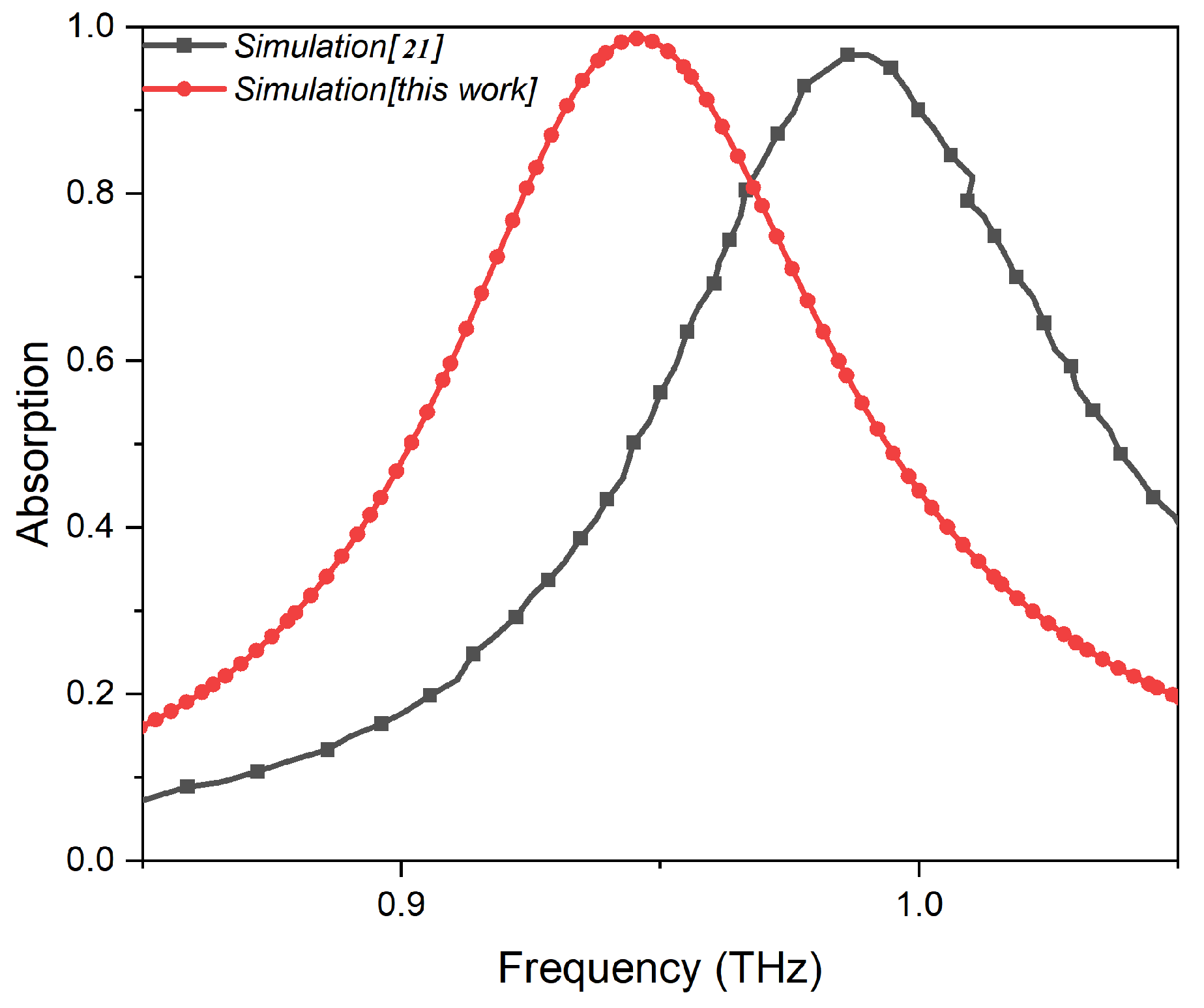
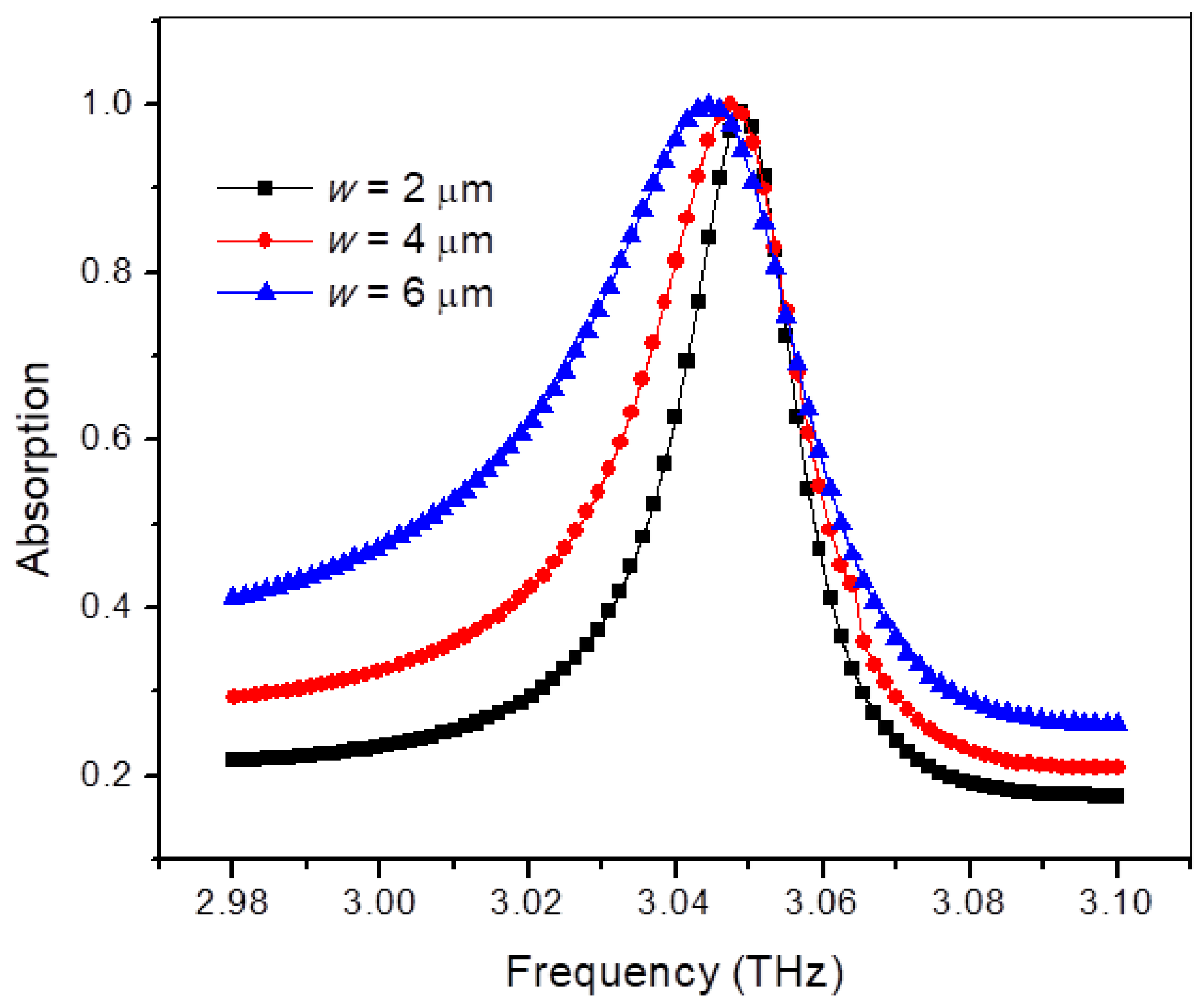
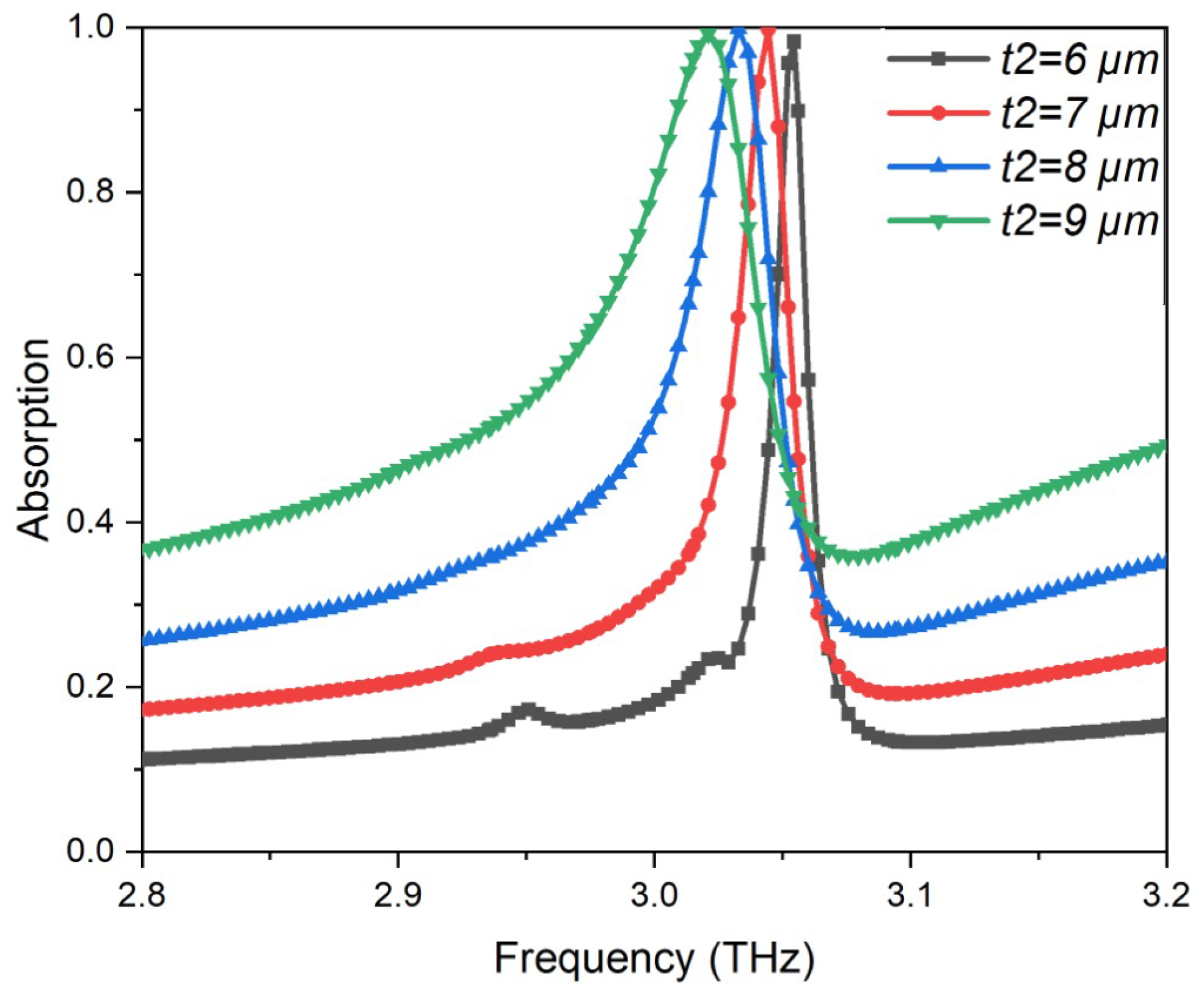

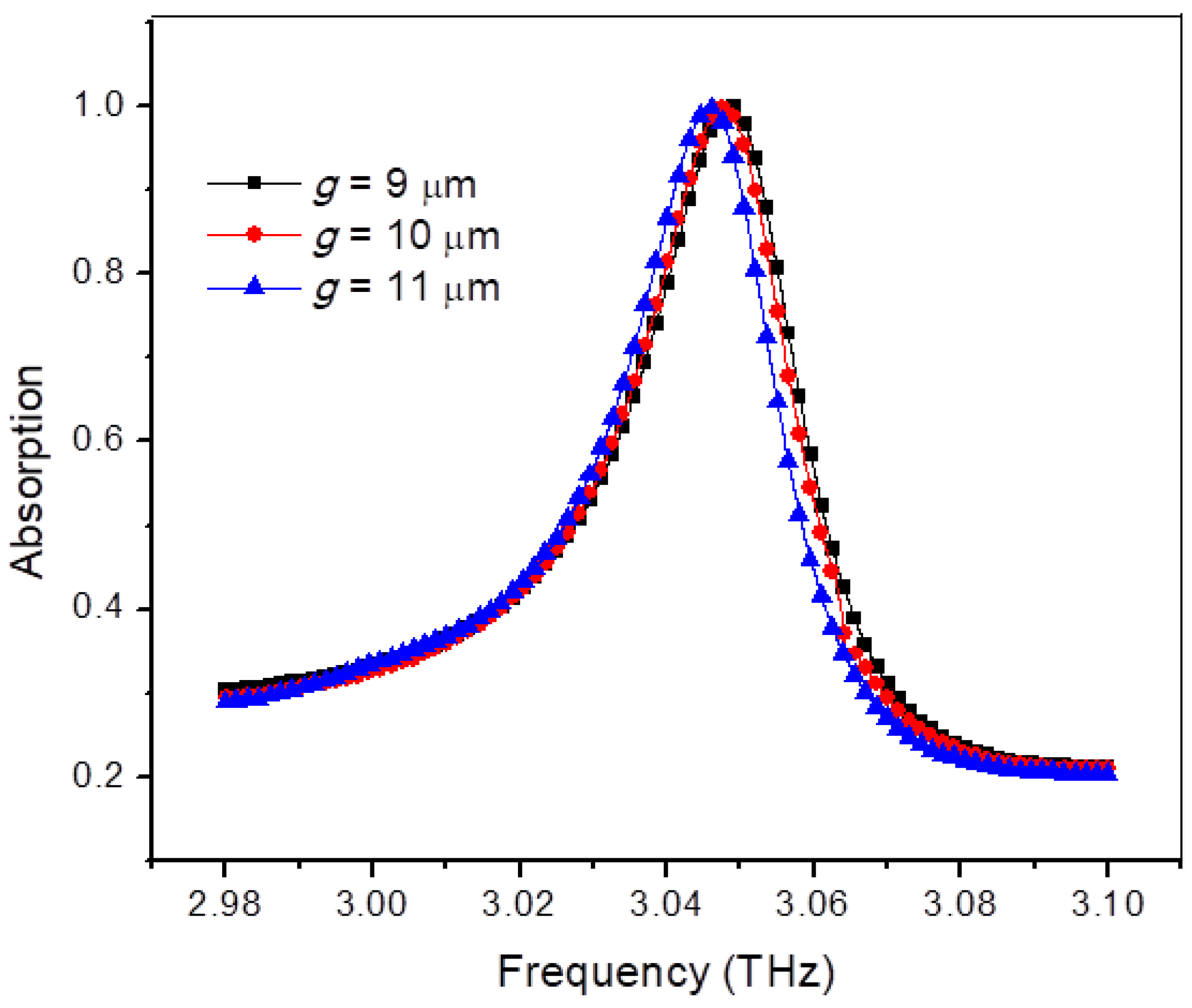
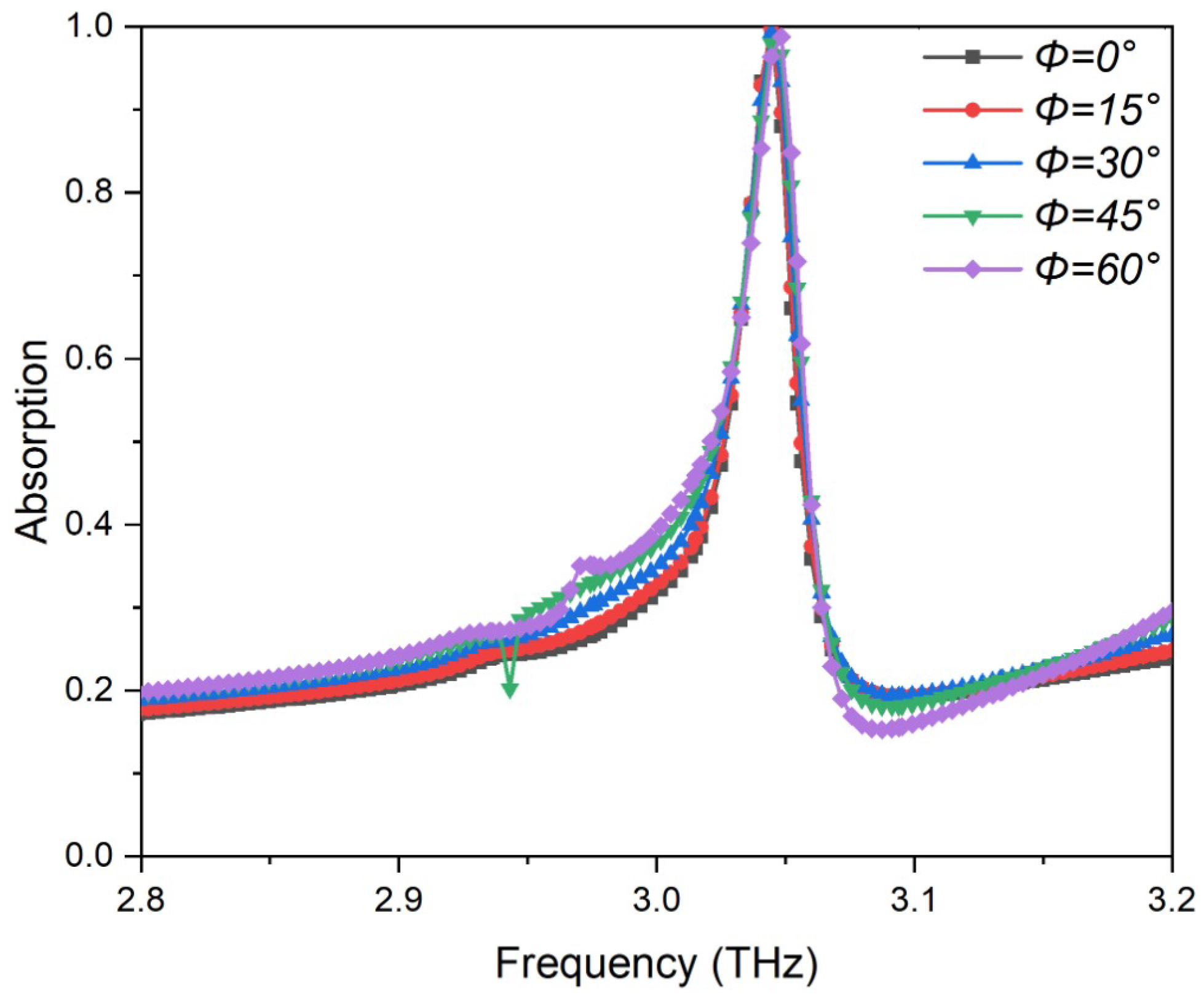

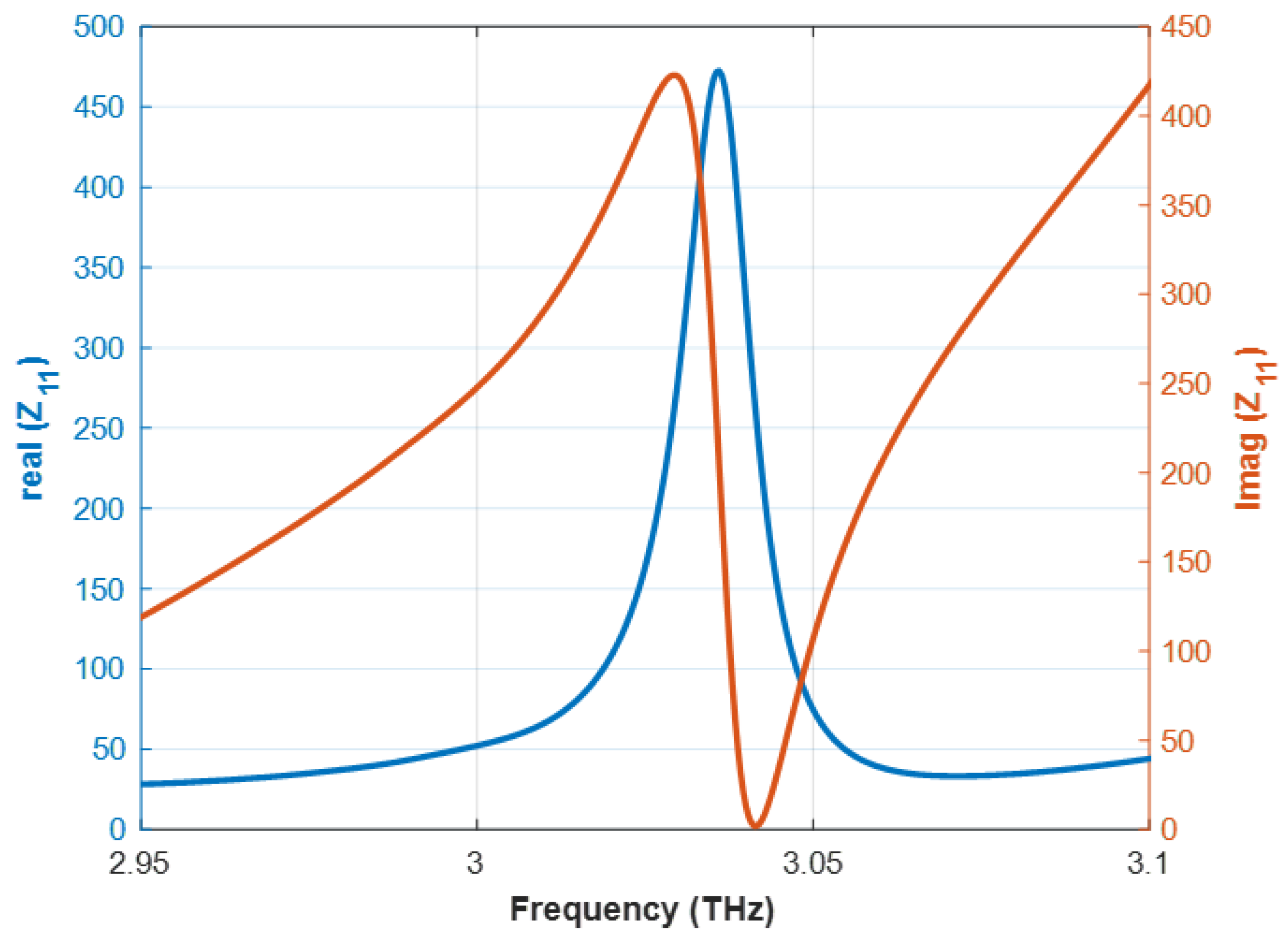
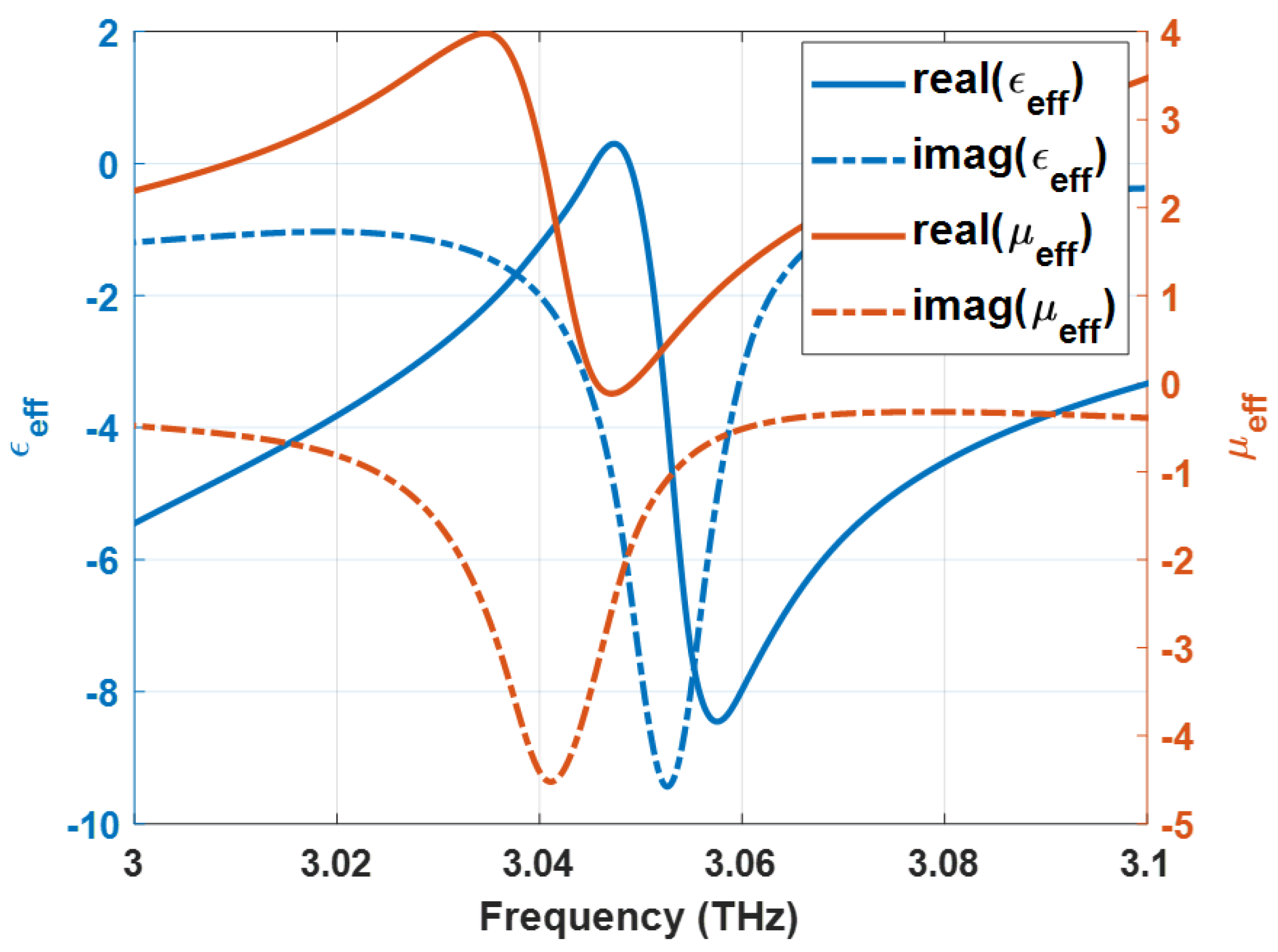
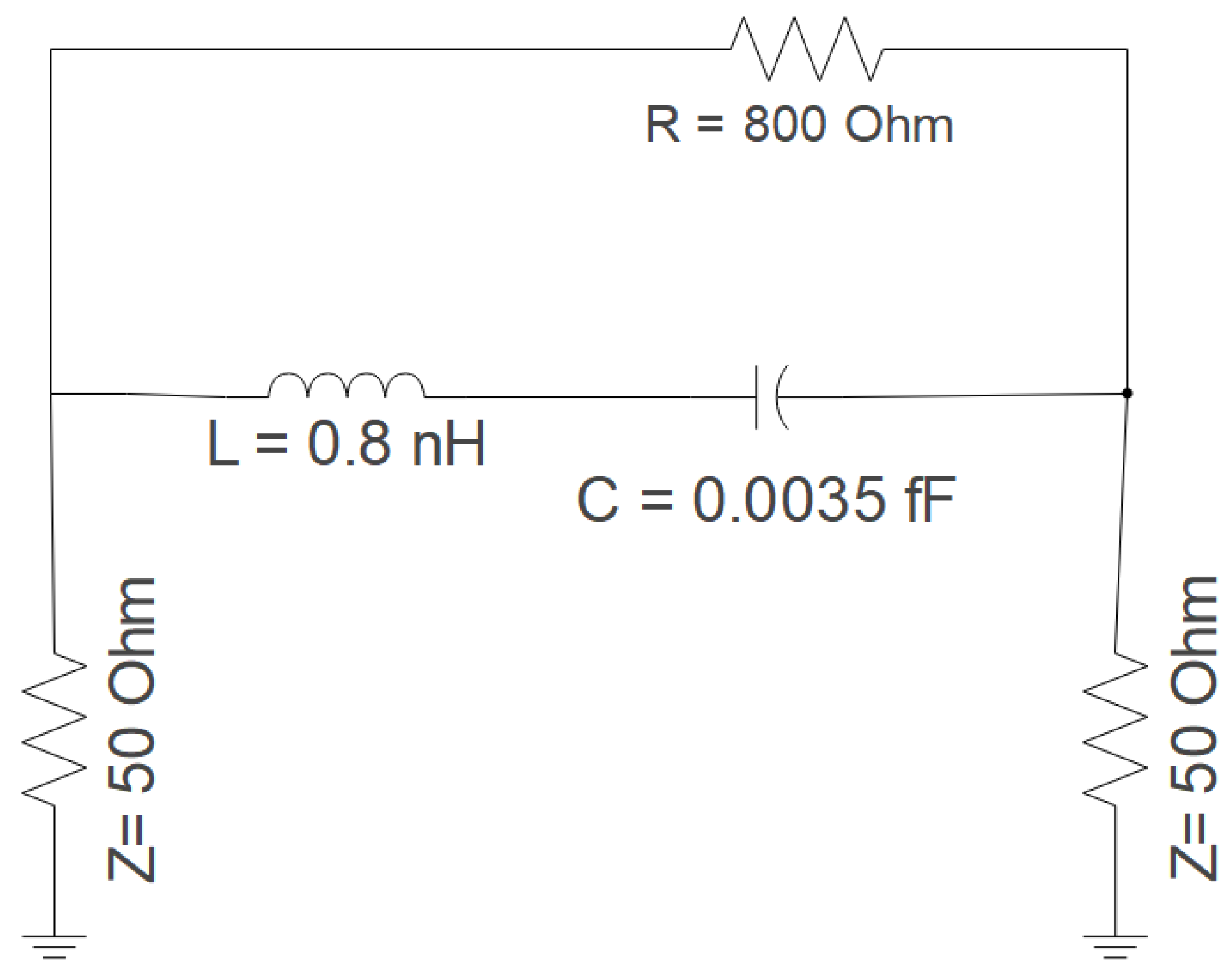
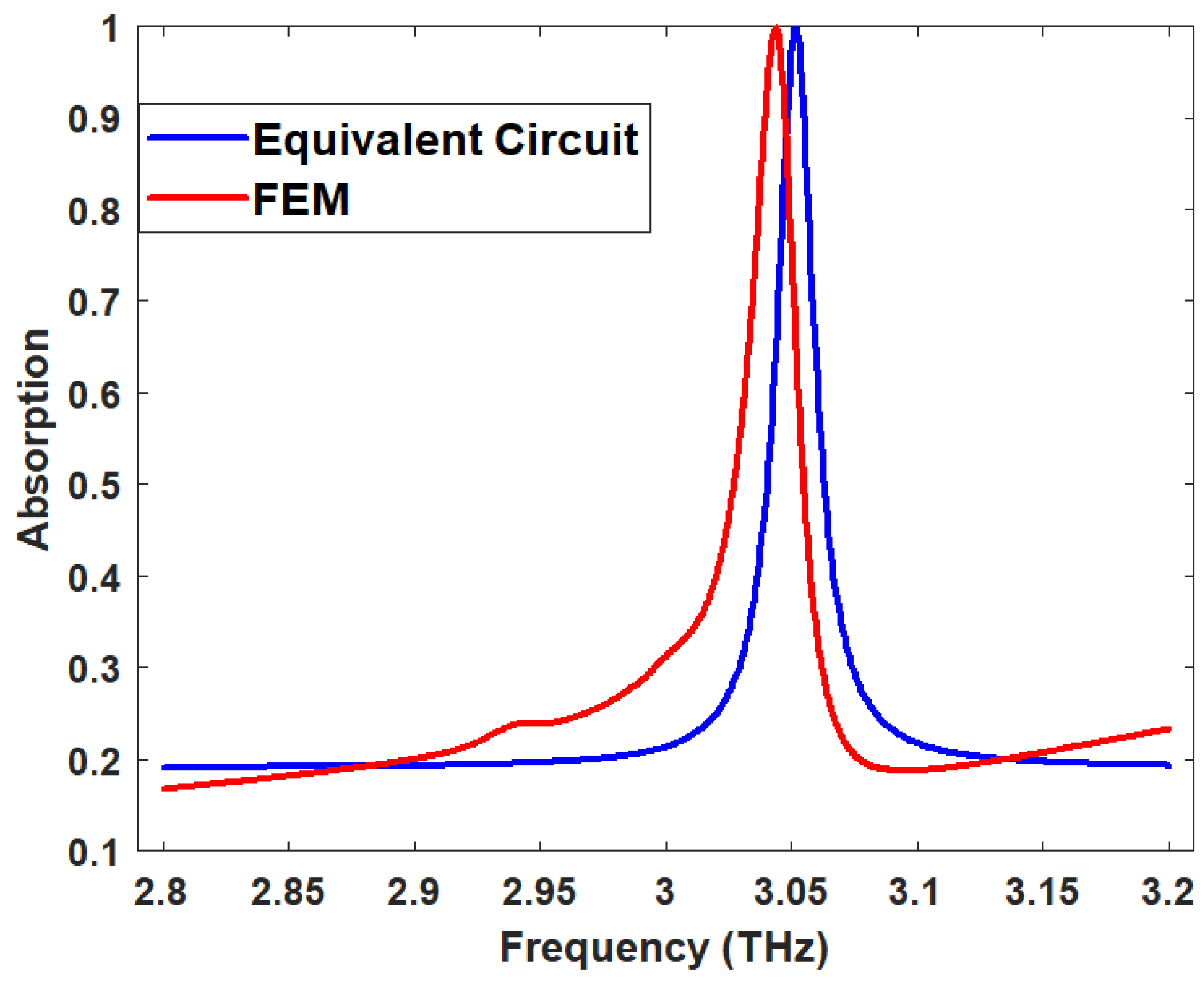



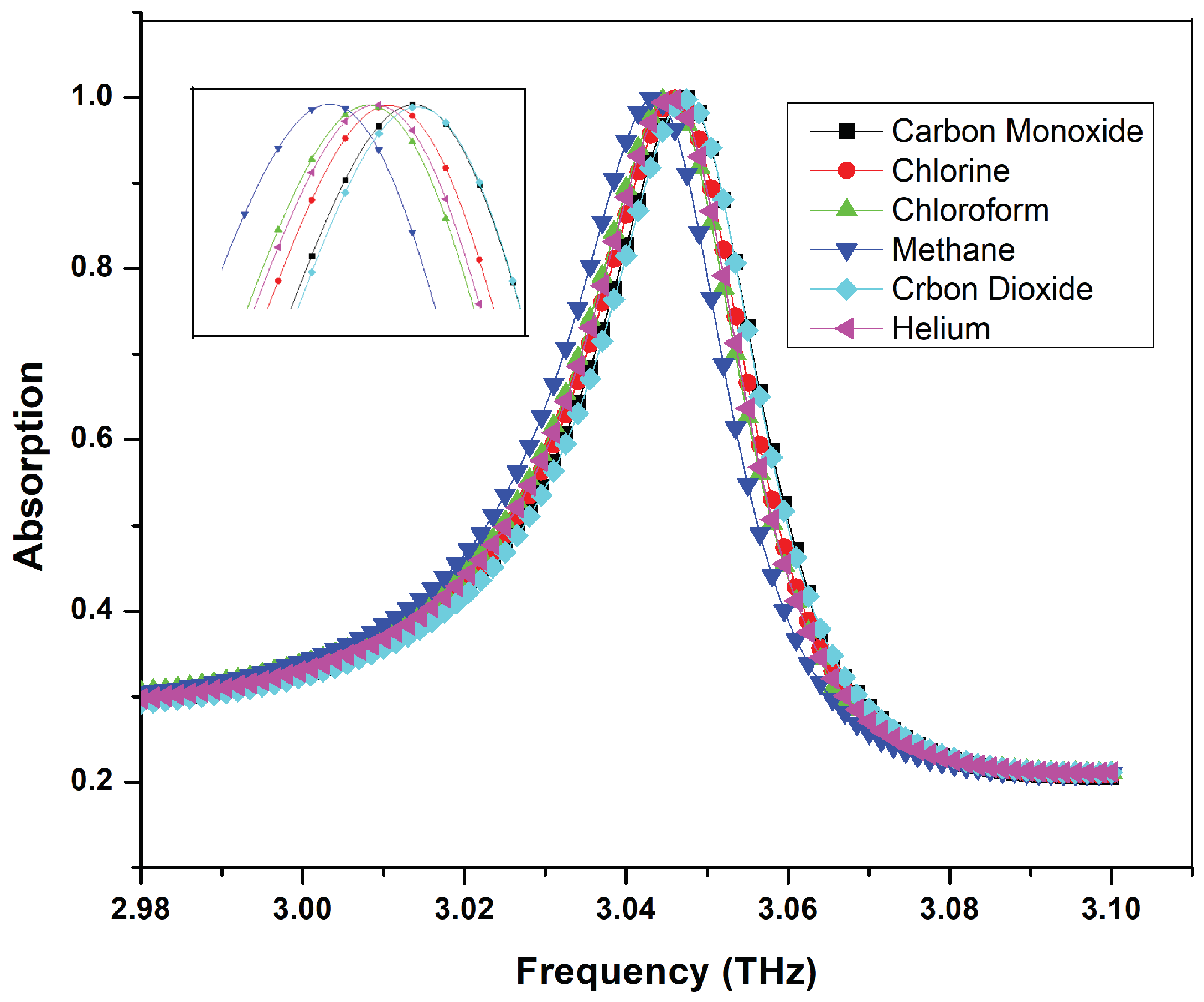
| Harmful and Toxic Gases | Refractive Index |
|---|---|
| Carbon monoxide | 1.000338 |
| Chlorine | 1.000773 |
| Chloroform | 1.001450 |
| Methane | 1.000444 |
| Carbon Dioxide | 1.00045 |
| Helium | 1.000036 |
| Design | Range of R.I | Absorption Rate | Resonance Frequency (THz) | Sensitivity | FWHM (THz) | FoM | Gas Detection | Eq. ckt |
|---|---|---|---|---|---|---|---|---|
| Ref. [35] | 1 to 1.39 | 99% | 2.249 | 23.7 GHz/μm | 0.102 | 2.94 | No | No |
| Ref. [36] | 1 to 1.8 | 99.8% | 1.8 | 187.5 GHz/RIU | - | 223 | No | No |
| Ref. [37] | 1 to 1.8 | 99.6% | 2.26 | 360 GHz/RIU | - | 431 | No | No |
| Ref. [38] | 1 to 2 | - | 0.64, 1.94, 2.67 | 0.119 THz/RIU, 0.248 THz/RIU, 0.662 THz/RIU | - | - | No | No |
| Ref. [39] | 1.2 to 2 | 96.4% | - | 34.40% RIU−1 | - | 19.35 | No | No |
| Ref. [31] | 1 to 1.8 | - | 0.6376 | 163 GHz/RIU | 0.061 | 2.67 | No | No |
| Ref. [40] | 1 to 1.08 | 99.3% | 3.62 and 3.814 | 3 and 3.59 THz/RIU | 0.07 and 0.0027 | 1329.63 | Yes | No |
| Proposed Work | 1.000 to 1.030 | 99.75% | 3.045 | 3.01 THz/RIU | 0.035 | 86 | Yes | Yes |
Disclaimer/Publisher’s Note: The statements, opinions and data contained in all publications are solely those of the individual author(s) and contributor(s) and not of MDPI and/or the editor(s). MDPI and/or the editor(s) disclaim responsibility for any injury to people or property resulting from any ideas, methods, instructions or products referred to in the content. |
© 2023 by the authors. Licensee MDPI, Basel, Switzerland. This article is an open access article distributed under the terms and conditions of the Creative Commons Attribution (CC BY) license (https://creativecommons.org/licenses/by/4.0/).
Share and Cite
Shruti; Pahadsingh, S.; Appasani, B.; Srinivasulu, A.; Bizon, N.; Thounthong, P. A Reconfigurable Terahertz Metamaterial Absorber for Gas Sensing Applications. Crystals 2023, 13, 158. https://doi.org/10.3390/cryst13020158
Shruti, Pahadsingh S, Appasani B, Srinivasulu A, Bizon N, Thounthong P. A Reconfigurable Terahertz Metamaterial Absorber for Gas Sensing Applications. Crystals. 2023; 13(2):158. https://doi.org/10.3390/cryst13020158
Chicago/Turabian StyleShruti, Sasmita Pahadsingh, Bhargav Appasani, Avireni Srinivasulu, Nicu Bizon, and Phatiphat Thounthong. 2023. "A Reconfigurable Terahertz Metamaterial Absorber for Gas Sensing Applications" Crystals 13, no. 2: 158. https://doi.org/10.3390/cryst13020158









